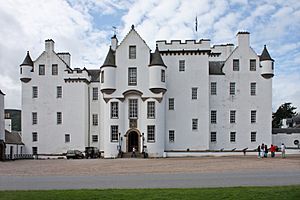Siege of Blair Castle facts for kids
Quick facts for kids Siege of Blair Castle |
|||||||
|---|---|---|---|---|---|---|---|
| Part of the Jacobite rising of 1745 | |||||||
 Blair Castle |
|||||||
|
|||||||
| Belligerents | |||||||
Royal Scots Fusiliers |
Clan Murray Clan Macpherson |
||||||
| Commanders and leaders | |||||||
| Strength | |||||||
| 300 | 1000 | ||||||
| Casualties and losses | |||||||
| Unknown | unknown | ||||||
The Siege of Blair Castle was a short but important battle in Scotland during March and April 1746. It was part of a bigger conflict called the Jacobite rising of 1745. This siege involved Scottish soldiers who supported the British government (led by King George II) defending Blair Castle. They were attacked by Scottish Jacobite forces who wanted to bring the old royal family, the House of Stuart, back to the throne.
Contents
What Led to the Siege?
In February 1746, Prince William, Duke of Cumberland, arrived in Perth with the king's army. He sent groups of soldiers to protect important areas. One group of 200 men went to Castle Menzies to guard a bridge. Another group of 300 men, led by Sir Andrew Agnew, 5th Baronet, was sent to protect Blair Castle.
Blair Castle was the home of James Murray, 2nd Duke of Atholl. Even though the Duke supported the British government, many people from his family group, the Clan Murray, supported the Jacobites. They were led by his own brother, Lord George Murray. This made the situation very complicated!
The Siege Begins
On the morning of March 17, the Jacobite forces surprised and captured the smaller guard posts around Blair Castle. The government soldiers at these posts were taken prisoner. The Jacobites then started shooting at the castle from nearby.
Inside the castle, the government soldiers, now about 270 strong, were told to stay in different parts of the building. They were ordered not to shoot unless they were directly attacked.
Later that day, Lord George Murray and Ewen MacPherson of Cluny, the leader of the Clan Macpherson, set up their base in the village of Blair. This village was very close to the castle. They sent a message to Sir Andrew Agnew, demanding that he give up the castle, his soldiers, and all their supplies. Sir Andrew Agnew bravely refused to surrender.
Trying to Get Help
On March 19, Sir Andrew Agnew sent a messenger on horseback to get help. He hoped the messenger would reach the Earl of Crawford, a general with British and Hessian (German) soldiers, who was thought to be in Perth or Dunkeld. However, it seemed the plan failed when a Jacobite was later seen riding the messenger's horse.
The Siege Ends
On April 1, the soldiers inside the castle heard good news: Lord George Murray and his men had left Blair. It's believed Murray had received orders to join the main Jacobite army, led by Young Pretender Charles Edward Stuart, near Inverness.
The very next day, April 2, the Earl of Crawford arrived with his cavalry (soldiers on horseback) to rescue the castle's defenders. It turned out that Agnew's messenger had actually fallen from his horse when Jacobites shot at him. But he managed to escape on foot and reach Crawford. The soldiers inside Blair Castle were very close to starving when the siege was finally lifted.
What Happened Next?
Lord George Murray and his men joined the army of Charles Edward Stuart. A few weeks later, they were defeated at the Battle of Culloden. The Royal Scots Fusiliers, who defended Blair Castle, also fought at Culloden, but they were on the winning British Government side.

